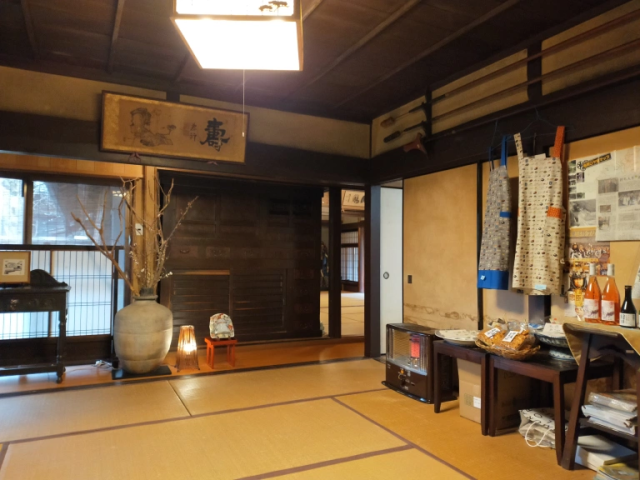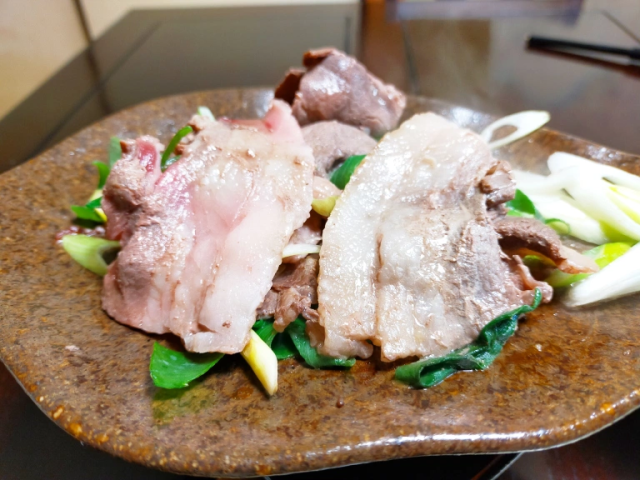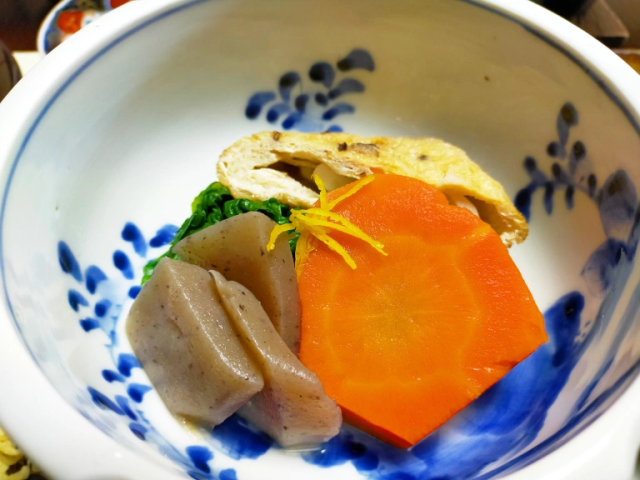
Genuine samurai chow served in an actual samurai home.
With fine dining at Michelin-starred restaurants in its major cities, Japan offers foodies ample opportunities to eat like a king. But what if, instead, you want to eat like a samurai warlord?
Then a visit to the town of Kameoka, in Kyoto Prefecture, is in order.
Sitting to the side of a quiet footpath that runs along low wall with a castle-like stone base is the restaurant Hekitei. Staring up at its majestic gate, you might think it looks like a samurai’s house, but you’d be wrong; it doesn’t look like a samurai house, because it is a samurai house.
▼ Note the spears hanging lengthwise at the top of the wall on the right.
Hekitei used to be the home of the head of the Heki samurai family, and was originally built over 300 years ago. It’s since been converted into a restaurant, though, and we decided to stop by when we heard that the house specialty is something called Busho Meshi, or the “Samurai Warlord Meal,” which includes a recreation of a dish actually eaten by one of Japan’s most famous samurai.
The town of Kameoka used to be the site of an official residence of Akechi Mitsuhide. Mitsuhide was a general serving under (and who later betrayed) Oda Nobunaga, one of Japan’s three great unifiers who brought the Sengoku period, Japan’s centuries-long civil war, to an end. Hekitei’s chefs researched historical documents related to Mitsuhide’s life, and from them were able to discover one of his favorite meals, which his wife Hiroko would often prepare and serve to the samurai and his vassals, and how to cook it. That dish is…
…miso soup, but it’s totally unlike the sort of miso soup you’ll find in modern Japanese restaurants. For starters, it’s got chunks of wild boar in it, something that’s unheard of in contemporary miso soup.
Generally, the major flavor for miso soup is a salty one, but with the boar’s juices mixing into the broth, the Samurai Warlord miso soup has a rich taste.
It’s also filled with starchy root vegetables, making it much hardier and more fortifying than thin mixture of broth, seaweed, and maybe a little tofu that’s the most common form miso soup takes. Honestly, it’s more like “miso stew” than “miso soup,” and it’s a fitting choice for a samurai, since the phrase “You can’t fight on a empty stomach” exists in Japanese too (“Hara ga hette ha ikusa ga dekinu.”)
There’s more to the 4,800-yen (US$44) Samurai Warlord Meal than just miso stew, though the rest of it doesn’t have an established historical connection to Mitsuhide. The exact sides vary seasonally, but on our visit we also got flat-grilled boar, okowa sticky mochi rice, and several other mouthwatering sides.
The seasonal vegetables were especially beautiful, sometimes looking like genuine works of decorative art.
And for dessert, there was matcha ice cream, a reminder that as cool as samurai may have been, living in the modern era can be pretty great too,
Everything was delicious, but the miso stew was definitely the standout of the bunch, especially as we sipped the samurai soup while sitting in a genuine samurai home, and we should add that we were also happy that our meal ended with a simple paying of the check, with far less drama than the conclusion of Mitsuhide’s life.
Restaurant information
Hekitei / へき亭
Kyoto-fu, Kameoka-shi, Chitosecho Bishamon Mukobata 40
京都府亀岡市千歳町毘沙門向畑40
Open noon-2 p.m., 5 p.m.-9 p.m.
Website
Photos ©SoraNews24
● Want to hear about SoraNews24’s latest articles as soon as they’re published? Follow us on Facebook and Twitter!
[ Read in Japanese ]



















 The spot in Kyoto where Japan’s most treacherous samurai was hunted down by bandits
The spot in Kyoto where Japan’s most treacherous samurai was hunted down by bandits Eat like a samurai from the warring states period with new range of canned meals from Japan
Eat like a samurai from the warring states period with new range of canned meals from Japan Recreating the greatest betrayal of the samurai era with the Honnoji Incident papercraft kit【Pics】
Recreating the greatest betrayal of the samurai era with the Honnoji Incident papercraft kit【Pics】 Miso soup capsule toys look good enough to eat, come with recipes to make the real thing!【Photos】
Miso soup capsule toys look good enough to eat, come with recipes to make the real thing!【Photos】 Which of Japan’s big three beef bowl chains has the best tonjiru pork miso soup?【Taste test】
Which of Japan’s big three beef bowl chains has the best tonjiru pork miso soup?【Taste test】 Dragon Quest Burgers and Slime drinks are coming to McDonald’s Japan【Video】
Dragon Quest Burgers and Slime drinks are coming to McDonald’s Japan【Video】 Our writer transforms into a rock goddess in hopes of teaming up legendary musician Yoshiki 【Vid】
Our writer transforms into a rock goddess in hopes of teaming up legendary musician Yoshiki 【Vid】 How to speak Japanese like a gyaru【2024 edition】
How to speak Japanese like a gyaru【2024 edition】 X Japan’s Yoshiki, L’Arc-en-Ciel’s Hyde preview co-op theme for Attack on Titan Season 3【Video】
X Japan’s Yoshiki, L’Arc-en-Ciel’s Hyde preview co-op theme for Attack on Titan Season 3【Video】 Japanese penguin plushie takes you from egg to chick to adult bird in seconds
Japanese penguin plushie takes you from egg to chick to adult bird in seconds Hayao Miyazaki says Happy New Year to Studio Ghibli fans with new art for Year of the Horse
Hayao Miyazaki says Happy New Year to Studio Ghibli fans with new art for Year of the Horse We revisited Sweets Paradise after a decade to see if Japan’s dessert buffet still delivers
We revisited Sweets Paradise after a decade to see if Japan’s dessert buffet still delivers The mystery of the phantom “sake pass card” at Japanese alcohol vending machines
The mystery of the phantom “sake pass card” at Japanese alcohol vending machines New world’s biggest Muji just opened in Japan, and we paid it a visit【Photos】
New world’s biggest Muji just opened in Japan, and we paid it a visit【Photos】 From beef bowl to beef pouch? Taste testing Yoshinoya’s instant gyudon packs
From beef bowl to beef pouch? Taste testing Yoshinoya’s instant gyudon packs Starbucks Japan ready to get Year of the Horse started with adorable drinkware and plushies【Pics】
Starbucks Japan ready to get Year of the Horse started with adorable drinkware and plushies【Pics】 Cyberpunk anime meets traditional culture in Ghost in the Shell gold leaf Japanese changing screens
Cyberpunk anime meets traditional culture in Ghost in the Shell gold leaf Japanese changing screens 7 great places to see Mt. Fuji from without having to climb it
7 great places to see Mt. Fuji from without having to climb it Hello Kitty Choco Egg figures are an adorable trip through three periods of Japanese pop culture【Pics】
Hello Kitty Choco Egg figures are an adorable trip through three periods of Japanese pop culture【Pics】 7-Eleven Japan’s ramen-cooking robot whipped us up a bowl of noodles【Taste test】
7-Eleven Japan’s ramen-cooking robot whipped us up a bowl of noodles【Taste test】 We found possibly the quietest Japanese-style hotel in Tokyo’s bustling Shinjuku district
We found possibly the quietest Japanese-style hotel in Tokyo’s bustling Shinjuku district Japan’s otoshidama tradition of giving kids money at New Year’s gets a social welfare upgrade
Japan’s otoshidama tradition of giving kids money at New Year’s gets a social welfare upgrade Sumo Sanrio! Hello Kitty and pals team up with Japan Sumo Association for new merch【Pics】
Sumo Sanrio! Hello Kitty and pals team up with Japan Sumo Association for new merch【Pics】 More Than a Capsule Stay: Why Solo Travelers Choose “global cabin Yokohama Chinatown”
More Than a Capsule Stay: Why Solo Travelers Choose “global cabin Yokohama Chinatown” Japan’s oldest largetooth sawfish in captivity back on display in Mie Prefecture
Japan’s oldest largetooth sawfish in captivity back on display in Mie Prefecture 7-Eleven Japan starts new temporary luggage storage service in over 300 branches
7-Eleven Japan starts new temporary luggage storage service in over 300 branches Disillusionment at Tsukiji’s tourist-target prices led us to a great ramen restaurant in Tokyo
Disillusionment at Tsukiji’s tourist-target prices led us to a great ramen restaurant in Tokyo Starbucks teams up with 166-year-old Kyoto doll maker for Year of the Horse decorations【Photos】
Starbucks teams up with 166-year-old Kyoto doll maker for Year of the Horse decorations【Photos】 Tokyo considering law requiring more trash cans following litter increase in heavily touristed area
Tokyo considering law requiring more trash cans following litter increase in heavily touristed area Tokyo’s Tsukiji sushi neighborhood asks tour groups to stay away for the rest of the month
Tokyo’s Tsukiji sushi neighborhood asks tour groups to stay away for the rest of the month Tokyo event lets you travel back in time, for free, to celebrate 100 years since Showa era start
Tokyo event lets you travel back in time, for free, to celebrate 100 years since Showa era start Sanrio theme park in Japan announces plans to expand into a Sanrio resort
Sanrio theme park in Japan announces plans to expand into a Sanrio resort Japan may add Japanese language proficiency, lifestyle classes to permanent foreign resident requirements
Japan may add Japanese language proficiency, lifestyle classes to permanent foreign resident requirements Stamina-destroying “Paralysis Noodles” are Tokyo’s newest over-the-top ramen innovation
Stamina-destroying “Paralysis Noodles” are Tokyo’s newest over-the-top ramen innovation Survey asks foreign tourists what bothered them in Japan, more than half gave same answer
Survey asks foreign tourists what bothered them in Japan, more than half gave same answer Japan’s human washing machines will go on sale to general public, demos to be held in Tokyo
Japan’s human washing machines will go on sale to general public, demos to be held in Tokyo Japan’s deadliest food claims more victims, but why do people keep eating it for New Year’s?
Japan’s deadliest food claims more victims, but why do people keep eating it for New Year’s? We deeply regret going into this tunnel on our walk in the mountains of Japan
We deeply regret going into this tunnel on our walk in the mountains of Japan Studio Ghibli releases Kodama forest spirits from Princess Mononoke to light up your home
Studio Ghibli releases Kodama forest spirits from Princess Mononoke to light up your home Major Japanese hotel chain says reservations via overseas booking sites may not be valid
Major Japanese hotel chain says reservations via overseas booking sites may not be valid Put sesame oil in your coffee? Japanese maker says it’s the best way to start your day【Taste test】
Put sesame oil in your coffee? Japanese maker says it’s the best way to start your day【Taste test】 No more using real katana for tourism activities, Japan’s National Police Agency says
No more using real katana for tourism activities, Japan’s National Police Agency says Starbucks Japan reveals new sakura drinkware collection, inspired by evening cherry blossoms
Starbucks Japan reveals new sakura drinkware collection, inspired by evening cherry blossoms Updated cherry blossom forecast shows extra-long sakura season for Japan this year
Updated cherry blossom forecast shows extra-long sakura season for Japan this year Kusaki Marino: A Japanese family restaurant where you bow your head and enter like a samurai
Kusaki Marino: A Japanese family restaurant where you bow your head and enter like a samurai Bando Taro proves family restaurants in Japan are on a whole other level
Bando Taro proves family restaurants in Japan are on a whole other level Stunning Japanese restaurant is like eating in a samurai residence
Stunning Japanese restaurant is like eating in a samurai residence A visit to the real-life Naruto Ramen Ichiraku anime restaurant that’s not in Japan【Photos】
A visit to the real-life Naruto Ramen Ichiraku anime restaurant that’s not in Japan【Photos】 If you want chashu without noodles, this Tokyo restaurant chain is the place for you【Taste test】
If you want chashu without noodles, this Tokyo restaurant chain is the place for you【Taste test】 We try chain restaurant miso ramen in Paris and find a slice of home overseas【Pics】
We try chain restaurant miso ramen in Paris and find a slice of home overseas【Pics】 Samurai manor house-style restaurant collabs with 150-year-old Kyoto matcha merchant for dessert
Samurai manor house-style restaurant collabs with 150-year-old Kyoto matcha merchant for dessert The restaurant where one of Japan’s last samurai lords ate now has a café with really good cake
The restaurant where one of Japan’s last samurai lords ate now has a café with really good cake Could you eat 50 beef cutlet refill pieces? If so, this Japanese restaurant will let you eat for free
Could you eat 50 beef cutlet refill pieces? If so, this Japanese restaurant will let you eat for free Tokyo family serves totally non-traditional super old-school katsudon at century-old restaurant
Tokyo family serves totally non-traditional super old-school katsudon at century-old restaurant All-you-can-eat oboro tofu restaurant in Kyoto is a guilt-free experience
All-you-can-eat oboro tofu restaurant in Kyoto is a guilt-free experience We visit the new all-you-can-eat KFC buffet restaurant in Tokyo
We visit the new all-you-can-eat KFC buffet restaurant in Tokyo Japanese conveyor belt restaurant delivers food by boat in Tokyo
Japanese conveyor belt restaurant delivers food by boat in Tokyo Why Gonpachi Nori-Temaki in Harajuku is a great Japanese restaurant for foreign tourists
Why Gonpachi Nori-Temaki in Harajuku is a great Japanese restaurant for foreign tourists Hey, Japanese taxi driver! Take us to your favorite restaurant in Tsuruga City!
Hey, Japanese taxi driver! Take us to your favorite restaurant in Tsuruga City!
Leave a Reply